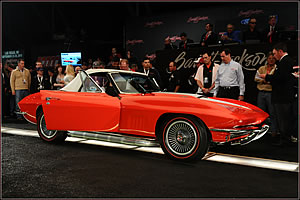3rd Annual Corvette Market Insider's Seminar at Barrett-Jackson - Page 2 of 2

Image: Barrett-Jackson
© 2010 by Tom Bryant
No use without permission, All Rights Reserved
What to hold:
Dave Burroughs would hold onto '63 to '72 high horsepower convertibles. He feels that a quality car with documentation will rise in value in the future.
Roy Sinor would hold onto a '67 435 if you know it's history. Documentation is important on a 435 as so many fakes are out there.
Jim Jordan likes survivors. There are fewer every day as they go under the restorers hammer.
Terry Michaelis is feeling good about the '63 Split Window Coupe in a fuel injection or 340 horse version with good colors. He also would hold any Corvette with a Z in the code. '70-'72 ZR1 or ZR2, ZL1, '63 Z06, or a car with a documented factory ordered M22 transmission. He also stated that any original, unrestored, well preserved car would be a good candidate to hold.
What to sell:
Dave Burroughs would sell '63-'66 average coupes under 360 horsepower; possibly convertibles too.
Jim Jordan would sell '90-'95 ZR1s. He feels that they have cashed out and will not increase in value anytime soon. They may actually loose some value in the near future.
Kevin Mackay says sell any basket case with a replacement block and no documentation. The exception here would be a car you bought for very little money that is mostly complete. An example would be that 500 dollar C1 that you bought in the '70s.
Terry Michaelis feels it's time to sell those '67 427/435s unless you have a truly original car that is well documented. They have cashed out and are not making profit like they once were.
Michael Pierce would sell any Corvette that would cost more to use or restore than it is worth or any Corvette with anything sticking up through the hood.
Roy Sinor would move any C3 or C4 that is not extremely well documented and rare.
Mike Yager's comment was to simply upgrade your collection. Let go of lesser cars to buy that one special car. Roy Sinor told an interesting story of selling his pair of '67 435s to buy a '67 L89. Then he found that the L89 had been sold.
What to buy:
Dave Burroughs would buy '53-'75s that are 75% unrestored with little deterioration.
Jim Jordan and Kevin Mackay agreed that the '68/'69 L88 with documentation is the car to buy. You can't buy a '67 L88 for 2 million and these cares should be worth half of that in ten years. They can be had now for 250 to 350 thousand with the best selling for around 650 thousand. Black is king.
Michael Pierce also agreed on the '68/'69 L88 but added in the L89. He felt strongly about any big tank car, 24or 36 gallon, and the solid lifter or fuel injection engines.
Terry Michaelis was still high on the '63 Split Window coupe in the right colors and with a high horsepower engine.
Roy Sinor said to buy a fuel injection or special high performance small block that is well documented or a restored car with a solid judging history.
Mike Yager would recommend a '63 Z06 or the Corvette Challenge cars.
The Holy Grail
Lastly the panel members were asked what they considered to be the holy grail of Corvettes. What would be the car they would buy if money was no problem and the car was available?
David Burroughs: 1967 L88 racer that he used to own.
Jim Jordon: Grand Sport number 2.
Kevin Mackay: Grand Sport number 4 with the L88 development engine as seen in 1965.
Terry Michaelis agreed on the Grand Sport number 2 but also added the '69 ZL1, '67 L88, '68/'69 L88, and a '63 FI Z06 tanker.
Mike Pierce would like the '63 Grand Sport number 2 or any of the 5 Grand Sports.
Roy Sinor would seek out a '67 L89 convertible with original motor, documented and extensive judging history.
Mike Yager would go for a '63 Grand Sport.
So there you have it. Remember that this was a Corvette Market seminar and not a slam on the Corvette that you love and cherish. The opinions stated were from the perspective of making solid investments in the Corvette market. If you have an older original Corvette think twice before blowing it apart for restoration or to build a restomod. There may be a better candidate out there for that purpose. Everyone on the panel has or has had a modified Corvette before so don't think for a minute that they are looking down their noses at anyone. They were just trying to point out where the market is going to help us all make better investment decisions. Thanks to Keith Martin for putting on a most interesting seminar. The turnout was way more than expected at around 267 and, no, I'm not going to blame the rain for everyone being indoors. Most of us would not have been there that early in the morning if the seminar wasn't happening. I'm looking forward to next year's event and maybe a little sunshine too.
